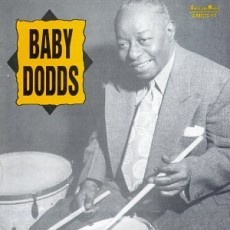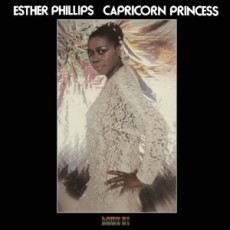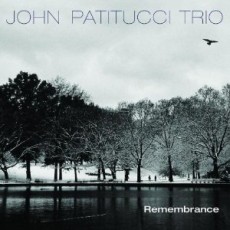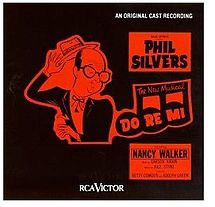
Daily Dose Of Jazz…
Warren “Baby” Dodds (pronounced “dots”) was born on December 24, 1898 in New Orleans, Louisiana. He was the younger brother of clarinetist Johnny Dodds and is regarded as one of the very best jazz drummers of the pre-big band era, and one of the most important early jazz drummers. Some of his early influences include Louis Cottrell, Harry Zeno, Henry Martin, and Tubby Hall.
Dodds gained reputation as a top young drummer in New Orleans, and worked on Mississippi River steamship bands with young Louis Armstrong. In 1921 moved to California to work with Joe “King” Oliver, and followed Oliver to Chicago, which would be his base of operations.
Dodds recorded with Louis Armstrong, Jelly Roll Morton, Art Hodes, his brother Johnny Dodds and by the late 1940s he worked at Jimmy Ryan’s in New York City. He also worked with Bunk Johnson when he would return to New Orleans. After suffering three strokes in 1949 and 1950, Dodds tutored and played in public irregularly, though he was unable to complete entire performances. In 1954 he played for a Natty Dominique recording session that featured bassist Israel Crosby and pianist Lil Hardin Armstrong.
Dodds was among the first drummers who improvised while performing to be recorded. He varied his drum patterns with accents and flourishes, and he generally kept the beat with the bass drum while playing buzz rolls on the snare. This play would be a long roll that lasted till the following beat, which created a smoother time feel that he later developed into the jazz ride pattern most commonly used ever since. He continues to be admired for the creativity of his playing and he believed in playing something different for every chorus of every tune. Additionally Dodds is perhaps the first jazz drummer to record unaccompanied: in 1945 he recorded two solos for Circle Records, and the next year recorded a series of solos and reminiscences for Folkways Records. Baby Dodds, jazz and Dixieland drummer passed away on February 14, 1959.
More Posts: drums

Daily Dose Of Jazz…
Esther Phillips was born Esther Mae Jones on December 23, 1935 in Galveston, Texas. He parents divorced when she was young and she shared her childhood between Houston and Los Angeles and brought up singing in church. At age fourteen she entered and won a local L.A. amateur talent contest that culminated in a recording with Johnny Otis for Modern Records and added her to his traveling revue, billed as Little Esther Phillips, a name she reportedly took from a gas station sign.
Her first hit record was “Double Crossing Blues” in 1950 for Savoy Records and after several hit records with Savoy that went to number one or hit the Billboard charts in the top ten, she was counted as one of the very few female artists that enjoyed such success in their debut year. She left Otis and Savoy for Federal Records but just a quickly as the hits came, they stopped, in part because she no longer worked with Otis and her increasing drug use that had her addicted by the middle of the decade.
By 1954, she was back home in Houston recuperating with her father, working small nightclubs around the South, punctuated by periodic hospital stays in Lexington, Kentucky, stemming from her addiction. In 1962, Kenny Rogers re-discovered her while singing at a Houston club and got her signed to his brother Lenox label, which assisted in her comeback. From Lenox she went to Atlantic Records, dropped “Little” from her name, and covered the Beatles’ “And I Love Him” and they flew her to the UK for her first overseas performance.
With the ushering in of 1972 she realized one of her biggest with her first album “From A Whisper To A Scream” for Creed Taylor’s Kudu Records with an account of drug use on the lead track in Gil Scott-Heron’s “Home Is Where The Hatred Is”. The song went on to be nominated for a Grammy Award but when Phillips lost to Aretha Franklin, the latter presented the trophy to Phillips, saying she should have won it instead.
While at Kudu she scored her biggest hit single with a disco-style update single of Dinah Washington’s “What A Difference A Day Makes” that reached the U.S. Top 20 and the UK Top 10. The subsequent album had her working with the Brecker Brothers, Joe Beck, David Sanborn, Steve Khan and Don Grolnick. She continued to record and perform throughout the 1970s and early 1980s, completing a total of seven albums on Kudu and four with Mercury Records.
At age 48, Esther Phillips died in Carson, California on August 7, 1984 from kidney and liver failure due to her on-going battle she waged with heroin dependency.
More Posts: vocal

The Jazz Voyager
Café Club del Jazz: Calle 47 42-38 Local 123 – Torres de Bombona, Medellin, Columbia. / Telephone: +574 2169331 / Contact: Christian Salgado. The only club dedicated entirely to Jazz. Offering live music Thursdays and Fridays, as well as lectures and conferences about jazz, video concerts and more. Drinks and food available.

Daily Dose Of Jazz…
John Patitucci was born December 22, 1959 in Brooklyn, New York and began playing electric bass at ten, composing and performing at 12, playing the acoustic bass at 15 and a year later the piano. A family move to the West Coast allowed him to study classical music at San Francisco State and Long Beach State universities.
By 1980 John’s career moved him to Los Angeles where he began a successful career as a studio musician and jazz artist. His long list of credits include twelve albums as a leader and a sideman for the likes of B.B. King, Chick Corea, Joanne Brackeen, Wayne Shorter, Herbie Hancock, Dizzy Gillespie, George Benson, Natalie Cole, Queen Latifah, Sting, Stan Getz, Astrud and Joao Gilberto, Henry Mancini, Danilo Perez, Wynton Marsalis, McCoy Tyner and the list goes on and on.
In 1986 he was voted by the National Academy of Recording Arts and Sciences as the Most Valuable Player on acoustic bass, he has won two Grammy Awards, he has reached number one on the Billboard Jazz charts and has won the reader’s polls: Best Jazz Bassist in Guitar Player Magazine’s and Best Jazz Bassist in Bass Player Magazine’s.
Patitucci has taught at music schools in several countries, was the Artistic Director of the Bass Collective, a school for bassists in New York City, is involved with the Thelonious Monk Institute of Jazz, the Betty Carter Jazz Ahead program and was appointed Associate Professor of Jazz Studies at City College of New York.
More Posts: bass

From Broadway To 52nd Street
Do-Re-Mi opened at the St. James on December 26, 1960 and starred Phil Silvers, Nancy Walker and John Reardon. Jule Styne, Betty Comden and Adolph Green composed the music and lyrics for the musical that ran 400 performances and gave the world the jazz standard Make Someone Happy.
The Story: A raucous satire on the music industry – with emphasis on the jukebox industry. Hubie Cram, a would-be big shot, induces three retired slot machine mobsters to muscle in on the jukebox racket. Though this does not make him the fawned upon tycoon he has always dreamed of becoming, Hubie does succeed in turning a waitress into a singing star.
Broadway History: The history of Black theater dates back to the turn of the century between 1890 and 1910 when the Black musical comedy was booming with the development of the Black musical theater. In 1903 composer Bert Williams and George Walker wrote “In Dahomey” and is considered the first all Black show on Broadway. The show returned a 400% profit to producers shattering the myth that Black shows were unprofitable. This was followed by a string of shows such as Shuffle Along, Showboat, How Come, The Chocolate Dandies, Africana and Keep Shufflin’. The rise of Black actors would make prominent stars of Ethel Waters, Pearl Bailey, Leslie Uggams, Bill Robinson, Josephine Baker, John Bubbles, Diahann Carroll, Ruby Dee and Sammy Davis Jr.
Over the following decades such shows as Porgy and Bess would come to Broadway along with Purlie, Raisin, Ain’t Misbehavin’, Golden Boy, Dreamgirls that would ultimately culminate in the establishment of the August Wilson Theatre, continuing the legacy of nearly a century of Black theater and inclusion in the Broadway lexicon.
Sponsored By
www.whatissuitetabu.com



